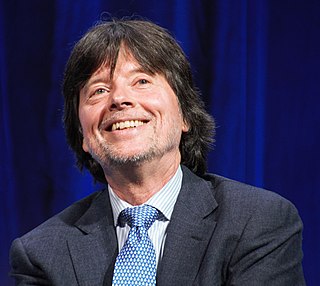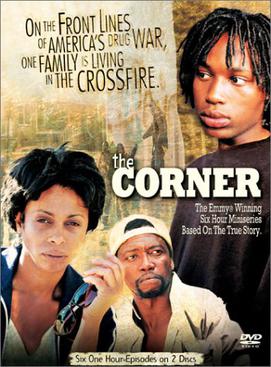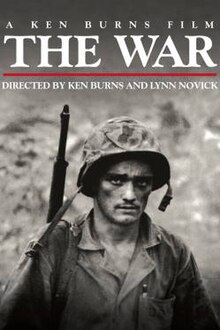Content
The series focuses on World War II in a "bottom up" fashion through the lenses of four "quintessentially American towns":
The series recounts the experiences of a number of individuals from these communities as they move through the war in the Pacific, African and European theaters, and focuses on the effect of the war on them, their families and their communities.
A number of notable actors including Adam Arkin, Tom Hanks, Keith David, Samuel L. Jackson, Josh Lucas, Bobby Cannavale and Eli Wallach are heard as voice actors reading contemporary newspaper articles, telegrams, letters from the front, etc. Notable persons including Daniel Inouye, Sidney Phillips, Joe Medicine Crow and Paul Fussell were interviewed.
The full documentary runs 14 hours and was broadcast in seven parts on PBS over two weeks, starting on Sunday, September 23, 2007 and continuing four nights the first week and three nights the second week, from 8 to 10 p.m. (8 to 10:30 p.m. on three nights). The documentary was provided to PBS affiliates in two versions: One with profanity generally prohibited by FCC regulations (including explanations of the acronyms FUBAR and SNAFU) and one without the expletives. [3]
Critical reception
TIME magazine's James Poniewozik named the series one of the Top 10 New TV Series of 2007, ranking it at no. 9. [4] Barry Garron of The Hollywood Reporter called The War an "artful masterpiece" and "[e]ven more ambitious than any previous Burns documentary, including ' The Civil War ,'" for its wide-ranging illustration of the impact of World War II on the United States and its citizens. [5] John Leonard of New York magazine also commended the miniseries, stating that though the documentary covers areas of the subject that have already been tackled in other World War II documentaries, "it's the nuanced, retrospective witness that makes the series so affecting, the testimonies of survivors who remember both who it is they used to be and the 408,000 fellow Americans who didn't make it." [6] Brian Lowry, writing for Variety , praised the miniseries as "a major victory for PBS", stating that it is "[a] monumental undertaking filled with moments of tremendous poignancy", though he noted that "The most significant quibble here is structural.... just when some stories begin to get interesting, that character is left, only to be returned to hours (and given the broadcast pattern, nights) later." [7]
Robert Koehler, another critic for Variety, found fault in the miniseries focusing mainly on the United States' role in World War II, emphasizing that it was unable to explore the various other conflicts in the war in depth such as the Japanese invasion of East and Southeast Asia and Operation Barbarossa. [8] Alessandra Stanley, writing for the New York Times , gave the series a mixed review, praising it as a "respectful, moving and meticulously illustrated anthology of small-town lives turned upside down by what one elderly veteran calls 'a necessary war,'" while also faulting it for "view[ing] the Second World War as a mostly domestic concern" in which "the London blitz, Stalingrad, Bergen-Belsen and the Warsaw uprising are parentheses." [9] Slate 's Beverly Gage echoed these thoughts saying "it's rousing and meaningful and not technically inaccurate, but not exactly the whole truth." [10] Jonathan Storm of The Philadelphia Inquirer wrote, "Once-in-a-lifetime viewing." [11]
Keith David received a Primetime Emmy Award for Outstanding Voice-Over Performance for his narration of the series. [12]
Controversy
The War came under fire after previews during the editing process indicated no mention of the contributions of Hispanics to the war effort, whose representation in the war itself is estimated at up to half a million people; complaints followed later as to omissions of Hispanic and Native American contributions and those of women in uniform. [13] [14] [15] Originally the premiere was scheduled for September 16, 2007; the fact that this date is both Mexican Independence Day and the start of U.S. observance of National Hispanic Heritage Month drew additional fire from its detractors, and the initial airdate was later moved to September 23, 2007, with no comment from PBS. [16]
Although at first the dispute seemed to be settled with the inclusion of additional footage to address the omission, in subsequent weeks, groups began to question conflicting reports from Burns and PBS as to whether the additional footage would be provided as supplementary material or would be integrated into the overall program. [17] [18] [19] Burns initially insisted that re-editing the series was out of the question, with PBS defending that decision on the basis of artistic freedom. Over the months of May and June, as of mid-July, 2007, estimates put out by Burns suggested that additional footage showing interviews with two Hispanics and one Native American would be added to the series, for a total of 28 minutes additional footage to the 14 hours the program was originally planned to cover; the additional footage would air at the conclusion of the selected episodes, but before each episode's final credits. [20]
News outlets began to report as of July 11 that the additional content had not been included in materials made available for preview by television writers and critics, prompting renewed discussion and speculation as to the eventual outcome of the debate.

Luverne is a city in Rock County, Minnesota, United States, along the Rock River. The population was 4,946 at the 2020 census. It is one of four towns profiled in the 2007 Ken Burns documentary The War. It is the main setting for the second season of the TV show Fargo.

Kenneth Lauren Burns is an American filmmaker known for his documentary films and television series, many of which chronicle American history and culture. His work is often produced in association with WETA-TV and/or the National Endowment for the Humanities and distributed by PBS.

The Civil War is a 1990 American television documentary miniseries created by Ken Burns about the American Civil War. It was the first broadcast to air on PBS for five consecutive nights, from September 23 to 27, 1990.

Peter Coyote is an American actor, director, screenwriter, author and narrator of films, theatre, television, and audiobooks. He worked on films such as E.T. the Extra-Terrestrial (1982), Cross Creek (1983), Jagged Edge (1985), Bitter Moon (1992), Kika (1993), Patch Adams (1998), Erin Brockovich (2000), A Walk to Remember (2002), and Femme Fatale (2002).

Keith David Williams is an American actor. He is known for his deep voice and screen presence in over 300 roles across film, stage, television, and interactive media.

Baseball is a 1994 American television documentary miniseries created by Ken Burns about the history of the sport of baseball. First broadcast on PBS, this was Burns' ninth documentary and won the 1995 Primetime Emmy Award for Outstanding Informational Series. It was funded in part by the National Endowment for the Humanities.

Geoffrey Champion Ward is an American editor, author, historian and writer of scripts for American history documentaries for public television. He is the author or co-author of 19 books, including 10 companion books to the documentaries he has written. He is the winner of seven Emmy Awards.
Jazz is a 2001 television documentary miniseries directed by Ken Burns. It was broadcast on PBS in 2001 and was nominated for an Emmy Award for Outstanding Documentary or Nonfiction Series. Its chronological and thematic episodes provided a history of jazz, emphasizing innovative composers and musicians and American history.

The Corner is a 2000 HBO drama television miniseries based on the nonfiction book The Corner: A Year in the Life of an Inner-City Neighborhood (1997) by David Simon and Ed Burns, and adapted for television by David Simon and David Mills. It premiered on HBO in the United States on April 16, 2000, and concluded its six-part run on May 21, 2000. The series was released on DVD on July 22, 2003. It won the Primetime Emmy Award for Outstanding Miniseries in 2000.

Gregory James Nava is an American film director, producer and screenwriter.

Quentin C. Aanenson was a World War II veteran fighter pilot and former captain of the 391st Fighter Squadron, 366th Fighter Group, 9th Air Force, Army Air Forces. He flew the P-47 Thunderbolt in the Normandy D-Day invasion and subsequent European campaign.

Ric Burns is an American documentary filmmaker and writer. He has written, directed and produced historical documentaries since the 1990s, beginning with his collaboration on the celebrated PBS series The Civil War (1990), which he produced with his older brother Ken Burns and wrote with Geoffrey Ward.

Carrier is a PBS documentary television series about the six-month deployment of the United States Navy aircraft carrier USS Nimitz in 2005 from the United States to the Middle East and back. There are ten episodes, and the series is supplemented by a 90-minute companion documentary film called Another Day in Paradise.
Laura Anne Karpman is an American composer, whose work has included music for film, television, video games, theater, and the concert hall. She has won five Emmy Awards for her work. Karpman was trained at The Juilliard School, where she played jazz, and honed her skills scatting in bars.

The West, sometimes marketed as Ken Burns Presents: The West, is a 1996 television documentary miniseries about the American Old West. It was directed by Stephen Ives and featured Ken Burns as executive producer. It was first broadcast on PBS on eight consecutive nights from September 15 to 22, 1996.

The National Parks: America's Best Idea is a 2009 television documentary miniseries by director/producer Ken Burns and producer/writer Dayton Duncan which features the United States National Park system and traces the system's history. The series won two 2010 Emmy Awards; one for Outstanding Nonfiction Series and one for Outstanding Writing for Nonfiction Programming in Episode 2 "The Last Refuge". A companion book (ISBN 978-0307268969) was released alongside.
The World Wars is a three-part, six-hour event miniseries by the History Channel that premiered on Monday, May 26, 2014, airing for three consecutive nights. An extended version of the series, divided into six episodes with never before seen footage, was subsequently broadcast on H2 and in more than 160 countries on June 22, 2014.

The Roosevelts: An Intimate History is a 2014 American documentary television miniseries directed and produced by Ken Burns. It covers the lives and times of the three most prominent members of the Roosevelt family, Theodore Roosevelt, a Republican and the 26th President of the United States; Franklin D. Roosevelt, a Democrat, the 32nd President of the United States, and fifth cousin of Theodore; and Eleanor Roosevelt, the longest-serving First Lady of the United States, a niece of Theodore, and wife of Franklin. As a result of the influence of Theodore and Franklin as Presidents, as well as Eleanor as First Lady, a modern democratic state of equal opportunity was begun in the United States. The series begins with the birth of Theodore in 1858 and ends with the death of Eleanor in 1962.

The Vietnam War is a 10-part American television documentary series about the Vietnam War written by Geoffrey C. Ward and directed by Ken Burns and Lynn Novick. The first episode premiered on PBS on September 17, 2017. The script is by Geoffrey Ward, and the series is narrated by Peter Coyote. This series is one of the few PBS series to carry a TV-MA rating.

The U.S. and the Holocaust is a 2022 three-part documentary miniseries about the United States' response to the Holocaust. The series was directed by Ken Burns, Lynn Novick, and Sarah Botstein, and was written by frequent Burns collaborator Geoffrey C. Ward.















